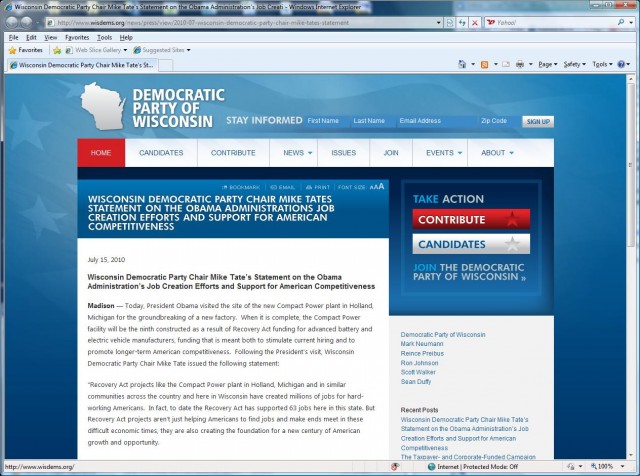Revisions/extensions (12:19 pm 7/21/2010) – The GAB finally got done collating Scott Walker’s report, so a look at it can now be made. That’s been appended to the bottom of the post.
The Government Accountability Board’s Campaign Finance Information System has once again proven inadequate to handle Scott Walker’s fundraising efforts, taking over 12 hours to generate the report but we can at least take a look at the other two major candidates’ finances for the first 6 months of the year.
First up, Democrat Tom Barrett. On the surface, things look rather normal, with about $1.8 million raised from individuals, another $191,000 from “conduits”, a relatively-minimal $45,000 in “in-kind” donations, and $348,000 from PACs for a total of $2,390,821.96 raised. Because, unlike Neumann and Walker, he does not face a serious challenger (just a person whose campaign Christian Schneider describes as a “crazy train”), the campaign only spent a tick over $1 million, and has $2,894,232.24 cash on hand with just under $11,000 in unspecified obligations to US Bank and no outstanding loans.
There are, however, a few “gems” in the report. With the ongoing government takeover of health care, an unusually large number of health-care providers decided to donate to Tom Barrett in what appears to be a desperate attempt to be the last private health-care provider standing. I won’t hold my breath for the media to notice that Big Med, like Big Finance, has shifted their donations to Democrats.
Speaking of Big Finance, it looks like Barrett is the official candidate of M&I Bank, at least before Walker’s report became available. A couple pages’ worth of donations (mostly in the conduit section) came from M&I employees.
Another significant donation base for Barrett is the “unemployed”. Another failing of the CFIS system is the lack of sortability, but the best I can determine, somewhere around 2 dozen “unemployed” people donated at least $100, with at least 7 topping the $1,000 donation mark, despite a lack of employment. I’d like to meet their financial planners; I can’t exactly afford to drop $1,000 on anything.
That brings me to Mark Neumann. His campaign took in $294,230 in individual donations, $1,760 in “conduit” donations and $23,181 in “in-kind” donations, and Mark loaned the campaign $2,525,070 the first 6 months of the year. Campaign expenses of $2,758,625.49, including $880,000 in loan repayments (more on that in a bit), left the campaign with $1,059,922.73 cash on hand, with $2,721,120 in personal loans still outstanding.
JR Ross of WisPolitics notes there’s a discrepancy between what Neumann’s campaign staff released and what the report has. That stems from the decision by the PR flacks to effectively not count the $880,000 in “flash cash” Neumann loaned his campaign on 12/31/2009 to make his numbers work and took back on 1/4/2010, as that $880,000 paid back was replaced by fresh personal loans.
I have to give credit to Patrick Marley and Lee Bergquist of the Milwaukee Journal Sentinel for twigging onto the “flash cash”, though they didn’t quite expound on it. The quick explanation:
- On 12/31/2009, the last day covered by the January 2010 continuing report, Mark Neumann loaned the campaign $970,000 to bring the total personal loan amount to $1,076,050.
- That $970,000 represented almost the entirety of the $974,177.55 cash on hand at the end of the day 12/31/2009.
- On 1/4/2010, after a minimal donation take and taking care of the expense of meeting the payroll, the campaign paid back Neumann $880,000 of that loan.
They also noted that Neumann loaned the campaign $1,000,000 on June 30, the last reporting day for this report. Once again, that represents almost the entirety of the cash on hand. However, since the campaign is in full-spending mode (as it should be), I don’t think we’ll find a “repayment” in the next report.
Finally, Scott Walker. His campaign took in just over $2.1 million in individual donations, about $222,000 in “conduits”, about $28,000 in in-kind donations, and just under $145,000 from PACs for a total of $2,589,997.95 raised. Campaign expenses of $2,016,721.81, including $101,090 in contemporary returned contributions and another $5,000 returned contribution initially made in 2005, left $2,571,774.80 cash on hand.
Speaking of those returned contributions, while the Walker campaign was the only one to specifically itemize returned contributions, the Barrett campaign noted that it returned some contributions in early July.
M&I appears to be playing both sides of the aisle, making significant donations to both Barrett and Walker. Again, the CFIS system does not allow for easy sorting of donations, so I cannot do more than a rough eyeball of the reports. The volumes of contributions are roughly equal between the two campaigns.
There is an oddity with the CFIS format of Walker’s report. Every other gubernatorial report that had multiple sources of individual donations had them in the order of monetary, conduit and in-kind (with Neumann’s loans appearing between the conduit and in-kind sections). That order on Walker’s report was reversed.
One more thing – there is exactly one active gubernatorial candidate people associated with Graef-USA donated to the past year, and it’s not Walker.

